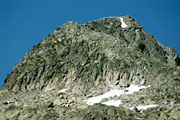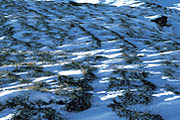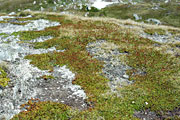 |
|
|
|
|
|
|
Here, we introduce three other plant communities you should
know, even though you did not encounter them on the virtual excursion,
because they occur solely on soils poor in calcium: the Carex curvula
– grassland, the Loiseleuria procumbens – heath
and the Androsace vandellii – rock community. |
|
Carex curvula - grassland on a smooth slope |
Carex curvula - grassland This type of grassland is widely distributed on flats and gentle slopes between 2300 and 2800 m a.s.l. in the siliceous Alps. The turf is closed, relatively species poor and dominated by the tussocks of the Alpine sedge (Carex curvula). Due to an ascomycetes (Pleospora elynae) colonizing the leaf tips of Carex curvula, they turn into brownish-yellow and let these grasslands always look dry and autumnal. |
|
A mountain peak formed of siliceous rock |
Androsace vandellii - rock community Rock surfaces are covered by algae, lichens or mosses. The geographic lichen (Rhizocarpon geographicum), for instance, is an encrusting lichen typically colonizing granite or gneiss and therefore acting as indicator for siliceous rocks. Vascular plants can only grow on rocks, if there are terraces covered by or crevices filled by fine soil serving as rooting substrate. The plants on rocks must be able to cope with extreme temperature differences and lack of water. Therefore, we often find species with succulent leaves or cushion plants in these habitats. |
|
December 30, 2001, 2100 m. Although in deep winter, the
snow cover of this wind-exposed site is very scanty. A carpet of Loiseleuria procumbens on a siliceous ridge
|
Loiseleuria procumbens – heath The evergreen dwarf shrub trailing azalea (Loiseleuria procumbens) forms flat carpets on ridges and crests on siliceous bedrock between 2000 and 2500 m a.s.l. Such places are often out of snow in winter and the plants growing there must be able to withstand temperatures down to –50°C. Frequently, other dwarf shrub species of the Ericaceae-familiy such as Alpine bilberry (Vaccinium gaultherioides) or crowberry (Empetrum nigrum subsp. hermaphroditum) occur together with Loiseleuria. Different fruticose lichens, such as species of reindeer moss (Cladonia sp.) or Iceland moss (Cetraria islandica), are interspersed with the shrubs; herbs and grasses are rather rare. |
29 August 2011 |
||
| |
||



